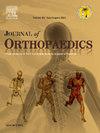胫骨后坡测量的比较分析:x线片和CT的准确性和可靠性
IF 1.5
Q3 ORTHOPEDICS
引用次数: 0
摘要
本研究旨在评估通过x线片和CT测量胫骨后坡(PTS)的准确性和可靠性。PTS,特别是其内侧和外侧测量的差异,在膝关节对齐中起着至关重要的作用,不同成像方式测量技术的不一致性引起了对准确性的担忧。材料与方法本回顾性研究包括98例日本患者和324例中国患者的腿部数据。通过长、短腿x线片和CT测量PTS。两名独立的外科医生评估了测量结果,并评估了观察者之间和观察者内部的可靠性。主要结果是内侧和外侧PTS测量的比较,而次要目的是评估胫骨长度对测量准确性的影响。研究显示,外侧PTS始终小于内侧PTS,平均差异为1.2°-1.9°。与全长胫骨测量相比,较短的腿部x线片往往低估PTS。短腿和长腿x线片测量结果的相关性表明,PTS测量结果更容易出现误差,这可能是由于胫骨弯曲等解剖学因素造成的。对于内侧PTS,观察者之间和观察者内部的可靠性较好,但对于外侧PTS,尤其是在使用x线片时,可靠性较差。结论为了准确测量内侧和外侧PTS,外科医生应考虑采用CT和MRI等附加检查方法。如果要在x线片上测量PTS,重点应该放在内侧PTS上,因为它往往提供更可靠的结果。本文章由计算机程序翻译,如有差异,请以英文原文为准。
Comparative analysis of posterior tibial slope measurements: Accuracy and reliability of radiographs and CT
Introduction
This study aimed to evaluate the accuracy and reliability of posterior tibial slope (PTS) measurements obtained from radiographs and CT. PTS, particularly its differences in medial and lateral measurements, plays a crucial role in knee alignment, and inconsistencies in measurement techniques across different imaging modalities have raised concerns about accuracy.
Materials and methods
This retrospective study included data from 98 Japanese patients legs and 324 Chinese patients legs. PTS was measured on long-leg and short-leg radiographs and CT. Two independent surgeons assessed the measurements, and the inter- and intra-observer reliability were evaluated. The primary outcome was the comparison of medial and lateral PTS measurements, while the secondary aim was to assess the impact of tibial length on measurement accuracy.
Discussion
The study revealed that lateral PTS was consistently smaller than medial PTS, with an average difference of 1.2°–1.9°. Shorter leg radiographs tend to underestimate PTS compared to full-length tibial measurements. The correlation between measurements from short and long leg radiographs showed that PTS measurements were more prone to errors, which may be due to anatomical factors such as tibial bowing. Inter- and intra-observer reliability were good for medial PTS but poor to moderate for lateral PTS, especially when using radiographs.
Conclusion
For accurate measurement of both medial and lateral PTS, surgeons should consider using additional examination methods such as CT and MRI. If PTS is to be measured on radiographs, the focus should be on the medial PTS, as it tends to provide more reliable results.
求助全文
通过发布文献求助,成功后即可免费获取论文全文。
去求助
来源期刊

Journal of orthopaedics
ORTHOPEDICS-
CiteScore
3.50
自引率
6.70%
发文量
202
审稿时长
56 days
期刊介绍:
Journal of Orthopaedics aims to be a leading journal in orthopaedics and contribute towards the improvement of quality of orthopedic health care. The journal publishes original research work and review articles related to different aspects of orthopaedics including Arthroplasty, Arthroscopy, Sports Medicine, Trauma, Spine and Spinal deformities, Pediatric orthopaedics, limb reconstruction procedures, hand surgery, and orthopaedic oncology. It also publishes articles on continuing education, health-related information, case reports and letters to the editor. It is requested to note that the journal has an international readership and all submissions should be aimed at specifying something about the setting in which the work was conducted. Authors must also provide any specific reasons for the research and also provide an elaborate description of the results.
 求助内容:
求助内容: 应助结果提醒方式:
应助结果提醒方式:


